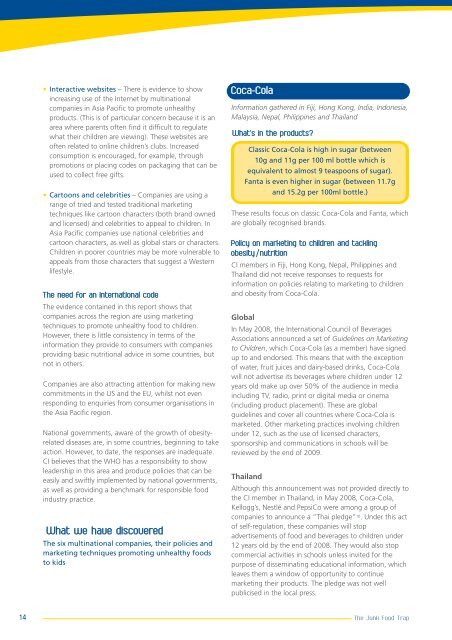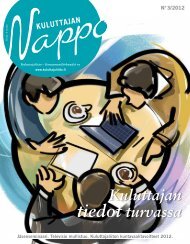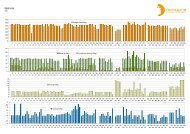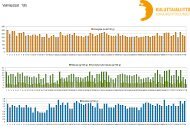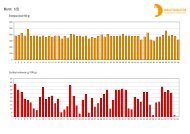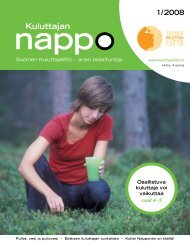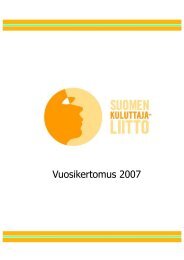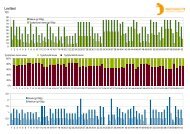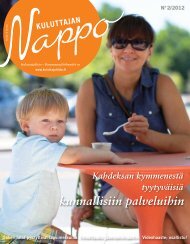Marketing unhealthy food to children in Asia Pacific - Consumers ...
Marketing unhealthy food to children in Asia Pacific - Consumers ...
Marketing unhealthy food to children in Asia Pacific - Consumers ...
- No tags were found...
You also want an ePaper? Increase the reach of your titles
YUMPU automatically turns print PDFs into web optimized ePapers that Google loves.
• Interactive websites – There is evidence <strong>to</strong> show<strong>in</strong>creas<strong>in</strong>g use of the Internet by mult<strong>in</strong>ationalcompanies <strong>in</strong> <strong>Asia</strong> <strong>Pacific</strong> <strong>to</strong> promote <strong>unhealthy</strong>products. (This is of particular concern because it is anarea where parents often f<strong>in</strong>d it difficult <strong>to</strong> regulatewhat their <strong>children</strong> are view<strong>in</strong>g). These websites areoften related <strong>to</strong> onl<strong>in</strong>e <strong>children</strong>’s clubs. Increasedconsumption is encouraged, for example, throughpromotions or plac<strong>in</strong>g codes on packag<strong>in</strong>g that can beused <strong>to</strong> collect free gifts.• Car<strong>to</strong>ons and celebrities – Companies are us<strong>in</strong>g arange of tried and tested traditional market<strong>in</strong>gtechniques like car<strong>to</strong>on characters (both brand ownedand licensed) and celebrities <strong>to</strong> appeal <strong>to</strong> <strong>children</strong>. In<strong>Asia</strong> <strong>Pacific</strong> companies use national celebrities andcar<strong>to</strong>on characters, as well as global stars or characters.Children <strong>in</strong> poorer countries may be more vulnerable <strong>to</strong>appeals from those characters that suggest a Westernlifestyle.The need for an <strong>in</strong>ternational codeThe evidence conta<strong>in</strong>ed <strong>in</strong> this report shows thatcompanies across the region are us<strong>in</strong>g market<strong>in</strong>gtechniques <strong>to</strong> promote <strong>unhealthy</strong> <strong>food</strong> <strong>to</strong> <strong>children</strong>.However, there is little consistency <strong>in</strong> terms of the<strong>in</strong>formation they provide <strong>to</strong> consumers with companiesprovid<strong>in</strong>g basic nutritional advice <strong>in</strong> some countries, butnot <strong>in</strong> others.Companies are also attract<strong>in</strong>g attention for mak<strong>in</strong>g newcommitments <strong>in</strong> the US and the EU, whilst not evenrespond<strong>in</strong>g <strong>to</strong> enquiries from consumer organisations <strong>in</strong>the <strong>Asia</strong> <strong>Pacific</strong> region.National governments, aware of the growth of obesityrelateddiseases are, <strong>in</strong> some countries, beg<strong>in</strong>n<strong>in</strong>g <strong>to</strong> takeaction. However, <strong>to</strong> date, the responses are <strong>in</strong>adequate.CI believes that the WHO has a responsibility <strong>to</strong> showleadership <strong>in</strong> this area and produce policies that can beeasily and swiftly implemented by national governments,as well as provid<strong>in</strong>g a benchmark for responsible <strong>food</strong><strong>in</strong>dustry practice.What we have discoveredThe six mult<strong>in</strong>ational companies, their policies andmarket<strong>in</strong>g techniques promot<strong>in</strong>g <strong>unhealthy</strong> <strong>food</strong>s<strong>to</strong> kidsCoca-ColaInformation gathered <strong>in</strong> Fiji, Hong Kong, India, Indonesia,Malaysia, Nepal, Philipp<strong>in</strong>es and ThailandWhat’s <strong>in</strong> the products?Classic Coca-Cola is high <strong>in</strong> sugar (between10g and 11g per 100 ml bottle which isequivalent <strong>to</strong> almost 9 teaspoons of sugar).Fanta is even higher <strong>in</strong> sugar (between 11.7gand 15.2g per 100ml bottle.)These results focus on classic Coca-Cola and Fanta, whichare globally recognised brands.Policy on market<strong>in</strong>g <strong>to</strong> <strong>children</strong> and tackl<strong>in</strong>gobesity/nutritionCI members <strong>in</strong> Fiji, Hong Kong, Nepal, Philipp<strong>in</strong>es andThailand did not receive responses <strong>to</strong> requests for<strong>in</strong>formation on policies relat<strong>in</strong>g <strong>to</strong> market<strong>in</strong>g <strong>to</strong> <strong>children</strong>and obesity from Coca-Cola.GlobalIn May 2008, the International Council of BeveragesAssociations announced a set of Guidel<strong>in</strong>es on <strong>Market<strong>in</strong>g</strong><strong>to</strong> Children, which Coca-Cola (as a member) have signedup <strong>to</strong> and endorsed. This means that with the exceptionof water, fruit juices and dairy-based dr<strong>in</strong>ks, Coca-Colawill not advertise its beverages where <strong>children</strong> under 12years old make up over 50% of the audience <strong>in</strong> media<strong>in</strong>clud<strong>in</strong>g TV, radio, pr<strong>in</strong>t or digital media or c<strong>in</strong>ema(<strong>in</strong>clud<strong>in</strong>g product placement). These are globalguidel<strong>in</strong>es and cover all countries where Coca-Cola ismarketed. Other market<strong>in</strong>g practices <strong>in</strong>volv<strong>in</strong>g <strong>children</strong>under 12, such as the use of licensed characters,sponsorship and communications <strong>in</strong> schools will bereviewed by the end of 2009.ThailandAlthough this announcement was not provided directly <strong>to</strong>the CI member <strong>in</strong> Thailand, <strong>in</strong> May 2008, Coca-Cola,Kellogg’s, Nestlé and PepsiCo were among a group ofcompanies <strong>to</strong> announce a “Thai pledge” 10 . Under this ac<strong>to</strong>f self-regulation, these companies will s<strong>to</strong>padvertisements of <strong>food</strong> and beverages <strong>to</strong> <strong>children</strong> under12 years old by the end of 2008. They would also s<strong>to</strong>pcommercial activities <strong>in</strong> schools unless <strong>in</strong>vited for thepurpose of dissem<strong>in</strong>at<strong>in</strong>g educational <strong>in</strong>formation, whichleaves them a w<strong>in</strong>dow of opportunity <strong>to</strong> cont<strong>in</strong>uemarket<strong>in</strong>g their products. The pledge was not wellpublicised <strong>in</strong> the local press.14 The Junk Food Trap


